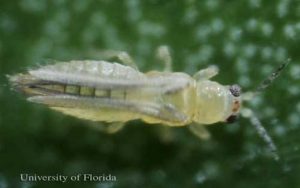Florida has the presence of many pests that can negatively affect crops and ornamental plants. Among these pests, we can find thrips. These are responsible for millions of economic losses on agricultural commodities and nurseries.
What are Thrips and How Can I Identify Them?
Thrips are piercing-sucking mouthpart insects, meaning they have a straw-like structure that allows them to extract plant sap. There are many different species of thrips in the world and only 1% are considered pests of economic importance. Thrips have the potential to feed on multiple species of nursery or crop plants. Thrips are tiny (approximately 1-2 mm in size), tend to hide in small spaces, have a fast reproductive life cycle, and have the ability to survive in multiple weather conditions, creating a

high risk for infestation. The adult thrips have wings while the larvae lack wings. Some species that could concern Florida producers are the western flower thrips, chilli thrips, weeping fig thrips, gladiolus thrips, and privet thrips.
What is Their Life Cycle?
Female thrips will deposit eggs on plant tissue. When the larva hatches, it immediately starts feeding on plant tissue. These insects have 2 instars that live on the plants: instar # 1 (1-2 days) and instar # 2 (2-4 days). After this, they go underground for a prepupa stage (1-2 days) and a pupa stage (1-3 days). They emerge as adults and return to plants to feed on plant tissue (30-45 days) and the cycle repeats itself.

What Damage Does Thrips Cause?
Thrips damage varies among the species. In general thrip damage can affect leaves, flowers, fruits, and plant shoots. When thrips lay eggs and feed on plant tissue it negatively affects them. Thrips can reduce plant yield and affect the economic value of ornamental and crop plants. Many species are vectors of viruses such as the western flower thrips which are known to transmit Impatiens Necrotic Spot Virus (INSV), Chrysanthemum Stem Necrosis Virus (CSNV), and the Tomato Spotted Wilt Virus (TSWV). When feeding they can scrap the outer layers of leaf cells causing silvering, bronzing, and leaf distortions. Their excrement can also cause tiny dark spots on the leaf surface decreasing the economic value of nursery plants. Flowers thrips prefer to feed on flowers (hence the name), and they can cause bud scaring, distortion, and discoloration to the petals.

How do I Control Thrips?
As with any other pests, there are multiple ways to control thrips. Utilizing monitoring practices and Integrated Pest Management (IPM) is the most effective way to control these insects.
Monitoring – Scouting is essential when controlling thrips. Eliminating a problem before severely impacting your plants could help you save thousands of dollars. When scouting producers should look for either the presence of the pests or the damage caused by the pest. Producers should develop an economic threshold to determine what populations and damage are going to be tolerated in a specific location. This will help them to understand when control will be necessary.
Sanitation – Cleaning debris, removing weeds, and eliminating old plant tissue, such as old flowers, could significantly reduce the number of thrips present in a location. All mentioned above could harbor thrips that could get transported into your plants.
Biological control – There are beneficial insects that feed on thrips. Examples of these include lady beetles, mantises, spiders, wasps, and lacewings. When spraying chemicals, try to use selective insecticides that will affect thrips but not beneficial insects. Keep in mind that biological control is most effective in low or early infestations. On highly infested plants biological control won’t be effective and may not stop plant damage.

Physical control – Exclusion is an effective method for thrips control. In a greenhouse, producers can use a mesh/screen (<0.8mm) that effectively prevents thrips from entering the location. When using a screen, take into consideration airflow movement inside the greenhouse.
Chemical control – insecticides are the most effective way to control thrips. When using pesticides follow label instructions for the proper application of the chemical treatment. Thrips like to hide in cracks and crevices, so a thorough application is important. Producers should also take into consideration pesticide rotation. Rotating the pesticide with different modes of action can avoid possible pesticide resistance among thrips. When using pesticides to control thrips, applications on intervals of 5-7 days are recommended to destroy thrips life cycles, however, always follow label instructions as mentioned before.
For more information about thrips, access the following “Ask IFAS” publications:
THRIPS MANAGEMENT PROGRAM FOR HORTICULTURAL CROPS
WESTERN FLOWER THRIPS (FRANKLINIELLA OCCIDENTALIS [PERGANDE])
CHILLI THRIPS SCIRTOTHRIPS DORSALIS HOOD (INSECTA: THYSANOPTERA: THRIPIDAE
University of Florida is an Equal Opportunity Institution
 2
2
